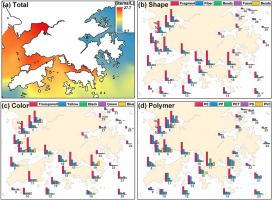Disentangling the anthropogenic and environmental correlates of microplastic pollution in the coastal waters of a metropolis in Southern China
IF 7.3
2区 环境科学与生态学
Q1 ENVIRONMENTAL SCIENCES
引用次数: 0
Abstract
Microplastics are widely recognized as significant marine pollutants with health implications, yet their abundance patterns, sources, and environmental determinants remain unknown in many regions. In this study, we surveyed 31 sites to assess the status of microplastic pollution in the surface waters of Hong Kong, one of the most densely populated cities in Southern China. Microplastics (20 μm–5 mm) were detected at all survey sites, with abundances ranging from 29 to 2.7 items/L (mean: 14.4 ± 8.6 items/L) along an estuary-to-ocean gradient. The highest abundances were observed in the western estuarine sites, which receive substantial river runoff, and within Victoria Harbour, which receives effluents from a major sewage treatment plant. Low-density polymers such as polypropylene (PP) and polyethylene (PE) were predominant, while high-density polymers like polyethylene terephthalate (PET) and polyvinyl chloride (PVC) were less abundant, except near sewage outfalls in Victoria Harbour. High concentrations of polystyrene (PS) in Deep Bay, an oyster culture area, suggest that Styrofoam used in local oyster culture rafts is a potential pollution source. Multivariate analyses indicate that microplastic pollution in Hong Kong is influenced by local environmental factors, with four environmental proxies—salinity, chlorophyll a, E. coli, and total inorganic nitrogen—accounting for a significant portion of the spatial pattern in microplastic abundance. Overall, our study disentangles the complex influences of the Pearl River and local human activities on the abundance and distribution of microplastics in Hong Kong waters, highlighting the complexity of tracing the sources of these pollutants.


解开中国南方大都市沿海水域微塑料污染的人为和环境相关因素
微塑料被广泛认为是具有健康影响的重要海洋污染物,但在许多地区,它们的丰度模式、来源和环境决定因素仍然未知。在这项研究中,我们调查了31个地点,以评估香港地表水的微塑料污染状况,香港是中国南方人口最稠密的城市之一。在所有调查地点均检测到微塑料(20 μm ~ 5 mm),丰度范围为29 ~ 2.7个/L(平均:14.4±8.6个/L)。在吸收大量河流径流的西部河口地区,以及维多利亚港内,所观察到的丰度最高,这是一个主要污水处理厂的污水。低密度聚合物如聚丙烯(PP)和聚乙烯(PE)占主导地位,而高密度聚合物如聚对苯二甲酸乙二醇酯(PET)和聚氯乙烯(PVC)则较少,除了维多利亚港的污水排放口附近。在蚝养殖区后海湾发现高浓度的聚苯乙烯(PS),显示本地蚝养殖筏所使用的聚苯乙烯泡沫是一个潜在的污染源。多变量分析表明,香港微塑料污染受本地环境因子的影响,盐度、叶绿素a、大肠杆菌和总无机氮4个环境因子在微塑料丰度的空间格局中占有重要地位。总体而言,我们的研究厘清了珠江和本地人类活动对香港水域微塑料丰度和分布的复杂影响,凸显了追踪这些污染物来源的复杂性。
本文章由计算机程序翻译,如有差异,请以英文原文为准。
求助全文
约1分钟内获得全文
求助全文
来源期刊

Environmental Pollution
环境科学-环境科学
CiteScore
16.00
自引率
6.70%
发文量
2082
审稿时长
2.9 months
期刊介绍:
Environmental Pollution is an international peer-reviewed journal that publishes high-quality research papers and review articles covering all aspects of environmental pollution and its impacts on ecosystems and human health.
Subject areas include, but are not limited to:
• Sources and occurrences of pollutants that are clearly defined and measured in environmental compartments, food and food-related items, and human bodies;
• Interlinks between contaminant exposure and biological, ecological, and human health effects, including those of climate change;
• Contaminants of emerging concerns (including but not limited to antibiotic resistant microorganisms or genes, microplastics/nanoplastics, electronic wastes, light, and noise) and/or their biological, ecological, or human health effects;
• Laboratory and field studies on the remediation/mitigation of environmental pollution via new techniques and with clear links to biological, ecological, or human health effects;
• Modeling of pollution processes, patterns, or trends that is of clear environmental and/or human health interest;
• New techniques that measure and examine environmental occurrences, transport, behavior, and effects of pollutants within the environment or the laboratory, provided that they can be clearly used to address problems within regional or global environmental compartments.
 求助内容:
求助内容: 应助结果提醒方式:
应助结果提醒方式:


